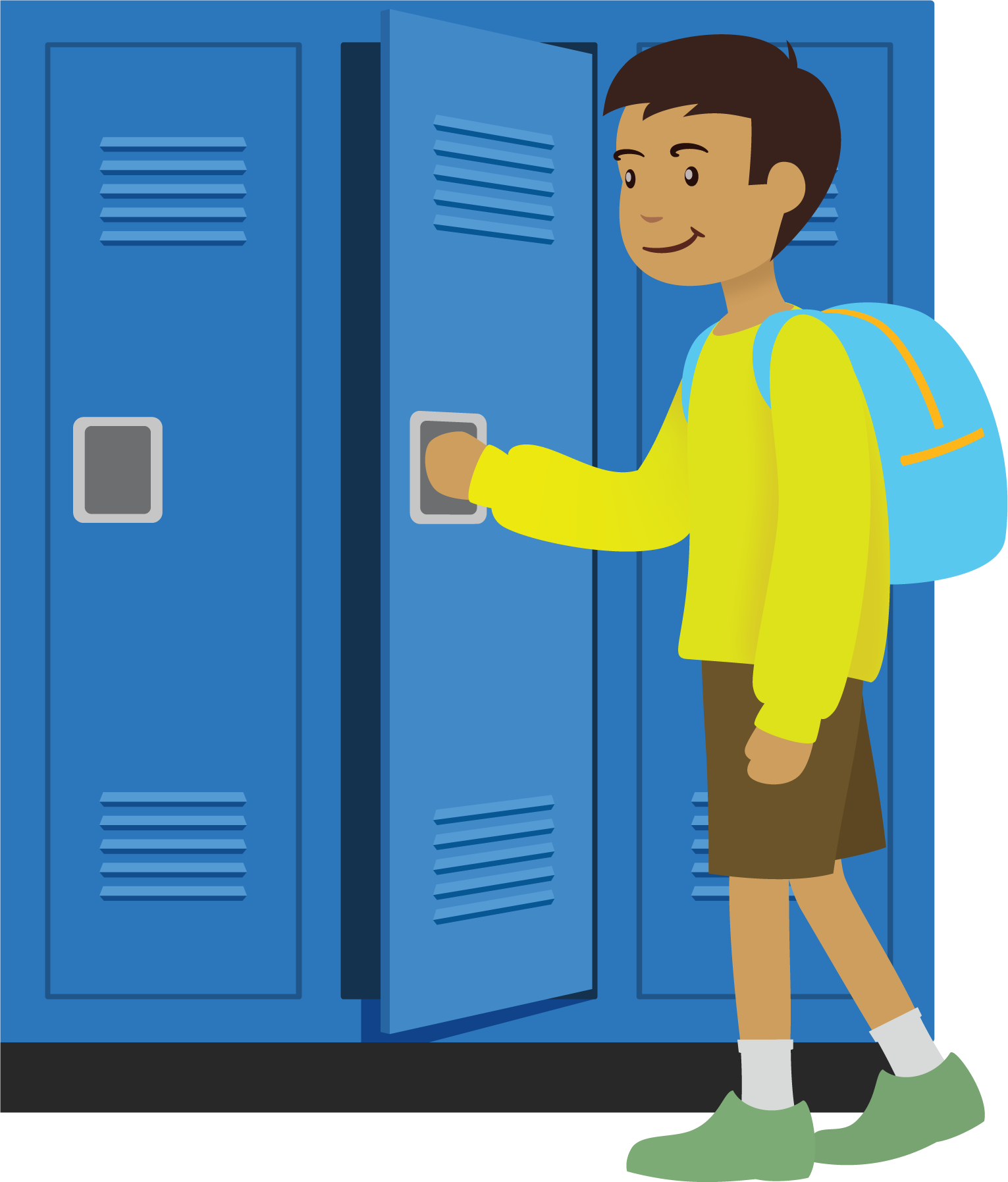Lesson 6
The Locker Problem
Warm-up: Choral Count: Twos and Fours (10 minutes)
Narrative
The purpose of this Choral Count is for students to practice counting by 2 and 4 and notice common multiples of the two numbers in the count. Students may notice that the count by 4 is every other number in the count by 2. The relationship between the two counts can also be described using multiplication and this is the goal of the synthesis.
Launch
- “Count by 2, starting at 0.”
- Record as students count.
- Stop counting and recording at 30.
- Count by 4, starting at 0.
- Record as students count.
- Stop counting and recording at 60.
Activity
- “What patterns do you see?”
- 1–2 minutes: quiet think time
- Record responses.
Student Response
For access, consult one of our IM Certified Partners.
Activity Synthesis
- “How can I get the number in the second list from the corresponding number in the first list?” (Double it by adding it to itself or multiply the number by 2.)
- “How can I get the number in the first list from the corresponding number in the second list?” (I can take half of it or divide the number by 2.)
Activity 1: Questionable Lockers (10 minutes)
Narrative
The purpose of this activity is for students to visualize and make sense of the context of problems they will solve in the next activity. They will also consider representations that can be used to model the quantities and actions in the situation (MP4) and try creating them. Students will not have time to make a complete representation, so the focus is on making sense of the situation and persevering in finding effective representations (MP1).
Required Materials
Materials to Gather
Launch
- Groups of 3 or 4
- Display the image of the lockers.
- “In your small group, discuss what you notice and wonder about the picture.”
- 1 minute: quiet think time
- 1 minute: group discussion
- Share and record responses. If students are not familiar with lockers, explain that lockers are used to hold students’ coats, books, and backpacks in some schools.
Activity
- Read the problem aloud to students.
- “Take some time on your own to make sense of the problem. You may want to try to visualize it or reread the problem.”
- 2 minutes: quiet think time
- Give students access to two-color counters, index cards, coins, and other materials that may be helpful to them.
- “Based on what you know, create a representation of the problem.”
- 5 minutes: independent work time
- Monitor for and select 3 different representations that:
- represent lockers in different ways
- show instances of contact with lockers (or of opening and closing)
- show correspondence between each student and the lockers touched
Student Facing
The picture shows lockers in a school hallway.
The 20 students in Tyler’s fourth-grade class are playing a game in a hallway that is lined with 20 lockers in a row.


- The first student starts with the first locker and goes down the hallway and opens all the lockers.
- The second student starts with the second locker and goes down the hallway and shuts every other locker.
- The third student stops at every third locker and opens the locker if it is closed or closes the locker if it is open.
This process continues until all 20 students in the class have touched the lockers.
Create a representation to show what you understand about this problem. Consider:
- How does your representation show lockers?
- How does your representation keep track of students who touch lockers?
- How does your representation show which lockers are open or closed?
Student Response
For access, consult one of our IM Certified Partners.
Activity Synthesis
- While discussing each representation, ask students:
- “Where are the lockers in this representation?” (Numbers or pictures used to indicate lockers)
- “How can we tell if a locker is open or closed in this representation?” (Symbols or colors used to indicate open or closed)
- “How does this representation show which student is touching the lockers?” (Students and their actions listed in a table or a T-chart)
- “In the next activity, you will answer questions about the game. You may use your representation or one shared by a classmate to help you think through the problems.”
Activity 2: An Open and Shut Case (25 minutes)
Narrative
The purpose of this activity is for students to solve problems about a locker game by using the ideas of factors and multiples and by observing patterns in the numbers. The situation offers many possible explorations, but the questions around which lockers are touched and by how many people are designed to elicit understandings about multiplication.
Discussion about which lockers will be open or closed or by whom will likely move students away from thinking about factors and multiples and should not be the focus. The final question challenges students who are ready for more to look for additional patterns and generalize their observations. It is not expected that all students complete it. Students who are ready may simulate opening and closing the lockers in different ways, such as:
- using actual lockers, if available
- using a printed set of squares labeled 1 through 20
- using two color counters and 10-frames, if available
- using the head and tail sides of coins
Advances: Representing, Conversing
Supports accessibility for: Conceptual Processing, Language, Attention
Launch
- Groups of 3–4
- “Let’s solve some problems about a game you read about earlier, where students take turns opening and closing lockers.”
- “Silently read and think about each question.”
- 1 minute: quiet think time
- “Work in your group to answer each question. Consider the representations you created or saw earlier to help you think about the problems.”
Activity
- 15–20 minutes: group work time
- Monitor for students who:
- represent each contact with the lockers in a systematic way
- represent the open and closed lockers in various ways
- reason about factors and multiples and use the vocabulary in their explanations
- Encourage students who use a pattern to answer the final question to share their explanation. Invite them to consider a situation with more lockers such as 50 or 100.
Student Facing
The 20 students in Tyler’s fourth-grade class are playing a game in a hallway with 20 lockers in a row.
Your goal is to find out which lockers will be touched as all 20 students take their turn touching lockers.


- Which locker numbers does the 3rd student touch?
- Which locker numbers does the 5th student touch?
- How many students touch locker 17? Explain or show how you know.
- Which lockers are only touched by 2 students? Explain or show how you know.
- Which lockers are touched by only 3 students? Explain or show how you know.
- Which lockers are touched the most? Explain or show how you know.
If you have time: Which lockers are still open at the end of the game? Explain or show how you know.
Student Response
For access, consult one of our IM Certified Partners.
Activity Synthesis
- “Take a few minutes to share your answers with students in a different group.”
- Invite students to share how they kept track of the number of touches for each locker.
- See lesson synthesis.
Lesson Synthesis
Lesson Synthesis
“Today, we looked at a game about lockers being opened and closed.”
“Which lockers were only touched by 2 students? What do those numbers have in common?” (2,3,5,7,11,13,17,19, They are all prime numbers.)
“Which lockers were only touched by 3 students? What do those numbers have in common?” (4, 9, 16. They all have an odd number of factors. One of their factor pairs involves the same number, like 3 and 3, or 4 and 4.)
“How do today's problems relate to what we've been studying?” (The factors of the locker numbers tell us how many and which students would touch the locker. If the locker number is a composite number, we know more than 2 students would touch the locker.)
Math Community
After the cool-down, ask students to individually reflect on the following question: “Which one of the norms did you feel was most important in your work today, and why?” Students can write their responses on the bottom of their cool-down paper, on a separate sheet of paper, or in a math journal.
Tell students that as their math community works together over the course of the year, the group will continually add to and revise its “Doing Math” and “Norms” actions and expectations.
Cool-down: Reflect on Problem Solving (5 minutes)
Cool-Down
For access, consult one of our IM Certified Partners.